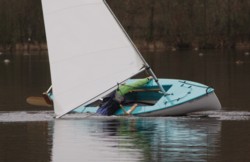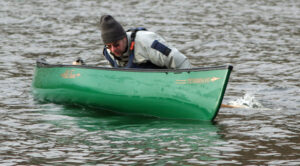 We have shown that most sailing canoes are capable of being recovered from a capsize by a ‘standard’ 75kg person and that the person can re-enter the canoe. The disadvantage for a heavier sailor is that a sailing canoe has limited stability and that trying to re-enter can easily cause the canoe to capsize towards you as you try and climb back in.
We have shown that most sailing canoes are capable of being recovered from a capsize by a ‘standard’ 75kg person and that the person can re-enter the canoe. The disadvantage for a heavier sailor is that a sailing canoe has limited stability and that trying to re-enter can easily cause the canoe to capsize towards you as you try and climb back in.

Removing the rig can help, as the weight of the mast and wet sail tends to tip the canoe over towards you. Having a set of mini outriggers can help to hold the canoe up as you climb back in; if you cannot manage without them then you should use them every time you go out sailing.
The newer SD Shearwaters have a small built-in water-ballast tank in the side tank next to the leeboard. This can be flooded as you right the canoe after a capsize. As you try and re-enter the canoe, the weight of water in the ballast tank on the opposite side will help to counterbalance your own weight as you climb back in. In an open canoe it is possible to recreate this counterbalancing effect by filling a spare dry bag with water and attaching it to the centre yoke on one side, while you are next to the canoe in the water. Then once you are on the opposite side and attempting to re-enter, tipping the canoe towards you, the ‘ballast’ bag will come out of the water and help hold that side down. This allows you to put more of your weight on the nearside gunwale as you re-enter the canoe without having it capsize on top of you. It should be practised beforehand to see if it works for you, then always have the spare dry bag ready at hand in case you need it for real.
 We have shown that most sailing canoes are capable of being recovered from a capsize by a ‘standard’ 75kg person and that the person can re-enter the canoe. The disadvantage for a heavier sailor is that a sailing canoe has limited stability and that trying to re-enter can easily cause the canoe to capsize towards you as you try and climb back in.
We have shown that most sailing canoes are capable of being recovered from a capsize by a ‘standard’ 75kg person and that the person can re-enter the canoe. The disadvantage for a heavier sailor is that a sailing canoe has limited stability and that trying to re-enter can easily cause the canoe to capsize towards you as you try and climb back in.